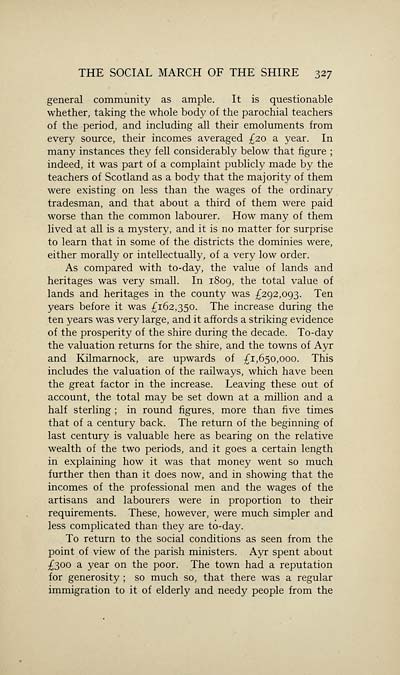Download files
Complete book:
Individual page:
Thumbnail gallery: Grid view | List view

THE SOCIAL MARCH OF THE SHIRE 327
general community as ample. It is questionable
whether, taking the whole body of the parochial teachers
of the period, and including all their emoluments from
every source, their incomes averaged £20 a year. In
many instances they fell considerably below that figure ;
indeed, it was part of a complaint publicly made by the
teachers of Scotland as a body that the majority of them
were existing on less than the wages of the ordinary
tradesman, and that about a third of them were paid
worse than the common labourer. How many of them
lived at all is a mystery, and it is no matter for surprise
to learn that in some of the districts the dominies were,
either morally or intellectually, of a very low order.
As compared with to-day, the value of lands and
heritages was very small. In 1809, the total value of
lands and heritages in the county was £292,093. Ten
years before it was £162,350. The increase during the
ten years was very large, and it affords a striking evidence
of the prosperity of the shire during the decade. To-day
the valuation returns for the shire, and the towns of Ayr
and Kilmarnock, are upwards of £1,650,000. This
includes the valuation of the railways, which have been
the great factor in the increase. Leaving these out of
account, the total may be set down at a million and a
half sterling ; in round figures, more than five times
that of a century back. The return of the beginning of
last century is valuable here as bearing on the relative
wealth of the two periods, and it goes a certain length
in explaining how it was that money went so much
further then than it does now, and in showing that the
incomes of the professional men and the wages of the
artisans and labourers were in proportion to their
requirements. These, however, were much simpler and
less complicated than they are to-day.
To return to the social conditions as seen from the
point of view of the parish ministers. Ayr spent about
£300 a year on the poor. The town had a reputation
for generosity ; so much so, that there was a regular
immigration to it of elderly and needy people from the
general community as ample. It is questionable
whether, taking the whole body of the parochial teachers
of the period, and including all their emoluments from
every source, their incomes averaged £20 a year. In
many instances they fell considerably below that figure ;
indeed, it was part of a complaint publicly made by the
teachers of Scotland as a body that the majority of them
were existing on less than the wages of the ordinary
tradesman, and that about a third of them were paid
worse than the common labourer. How many of them
lived at all is a mystery, and it is no matter for surprise
to learn that in some of the districts the dominies were,
either morally or intellectually, of a very low order.
As compared with to-day, the value of lands and
heritages was very small. In 1809, the total value of
lands and heritages in the county was £292,093. Ten
years before it was £162,350. The increase during the
ten years was very large, and it affords a striking evidence
of the prosperity of the shire during the decade. To-day
the valuation returns for the shire, and the towns of Ayr
and Kilmarnock, are upwards of £1,650,000. This
includes the valuation of the railways, which have been
the great factor in the increase. Leaving these out of
account, the total may be set down at a million and a
half sterling ; in round figures, more than five times
that of a century back. The return of the beginning of
last century is valuable here as bearing on the relative
wealth of the two periods, and it goes a certain length
in explaining how it was that money went so much
further then than it does now, and in showing that the
incomes of the professional men and the wages of the
artisans and labourers were in proportion to their
requirements. These, however, were much simpler and
less complicated than they are to-day.
To return to the social conditions as seen from the
point of view of the parish ministers. Ayr spent about
£300 a year on the poor. The town had a reputation
for generosity ; so much so, that there was a regular
immigration to it of elderly and needy people from the
Set display mode to:
![]() Universal Viewer |
Universal Viewer | ![]() Mirador |
Large image | Transcription
Mirador |
Large image | Transcription
Images and transcriptions on this page, including medium image downloads, may be used under the Creative Commons Attribution 4.0 International Licence unless otherwise stated. ![]()
| Histories of Scottish families > Ayrshire > Volume 1 > (337) Page 327 |
|---|
| Permanent URL | https://digital.nls.uk/95198330 |
|---|
| Attribution and copyright: |
|
|---|
| Description | A selection of almost 400 printed items relating to the history of Scottish families, mostly dating from the 19th and early 20th centuries. Includes memoirs, genealogies and clan histories, with a few produced by emigrant families. The earliest family history goes back to AD 916. |
|---|

